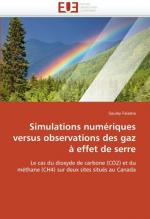|
This section contains 366 words (approx. 2 pages at 300 words per page) |
Methane is an invisible, odorless, and combustible gas present in trace concentrations in the atmosphere. It is the major component of natural gas, a fossil fuel commonly used for heating and cooking. The molecule consists of one carbon atom bonded to four hydrogen atoms (CH4), making it the simplest member of a chemical family known as hydrocarbons. Other hydrocarbons include ethane (C2H6), propane (C3H8), and butane (C4H10).
 Chemical structure of methane (CH4).
Chemical structure of methane (CH4).
As a greenhouse gas, methane ranks second to carbon dioxide. Methane levels, based on ice core samples, have more than doubled since 1750 (from 0.7 to 1.7 parts per million), largely due to human activity. On a molecule-for-molecule basis, methane is twenty-three times more potent as a greenhouse gas than carbon dioxide. Both gases are targeted for emissions reduction in the Kyoto Protocol.
Methane enters the atmosphere from both natural (30 percent) and anthropogenic (70 percent) sources. Methanogens (methane-producing bacteria in swamps and wetlands) are the largest natural source.
Anthropogenic sources of methane include leaks during fossil fuel mining, rice agriculture, raising livestock (cattle and sheep), and municipal landfills. Methanogens thrive in the oxygen-free (anaerobic) environment of landfills, releasing the gas in significant quantities. The gas is purposefully ignited to prevent explosion or captured for its commercial value as a fuel.
Livestock such as sheep, goats, camel, cattle, and buffalo currently account for 15 percent of the annual anthropogenic methane emissions. These grass-eating animals have a unique, four-chambered stomach. In the chamber called the rumen, bacteria break down food and generate methane as a by-product. Better grazing management and dietary supplementation have been identified as the most effective ways to reduce livestock methane emissions because they improve animal nutrition and reproductive efficiency. This general approach has been demonstrated by the U.S. dairy industry over the past several decades as milk production increased and methane emissions decreased.
Bibliography
DeLong, Eward F. (2000). "Resolving a Methane Mystery." Nature 407:577–579.
Simpson, Sarah. (2000). "Methane Fever." Scientific American 282(2):24–27.
Turco, Richard P. (1997). Earth under Siege: From Air Pollution to Global Change. New York: Oxford University Press.
Internet Resource
Intergovernmental Panel on Climate Change, Working Group I. "Atmospheric Chemistry and Greenhouse Gases." Climate Change 2001: The Scientific Basis. Available from http://www.ipcc.ch.
|
This section contains 366 words (approx. 2 pages at 300 words per page) |


